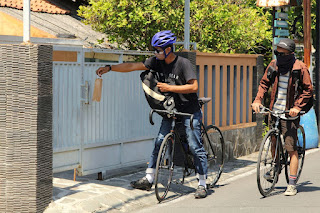Some of you may already know what I'm about to say: Some bikes and parts are really, really hard to find right now.
Those woes seem to have begun a month or two into the pandemic, when lockdowns shut down factories, warehouses and distribution centers, and disrupted supply routes. In some places, even bike shops were shut because they weren't deemed "essential businesses."
Now, a year and a half in, the situation doesn't seemed to have improved. I was able to do my most recent build only because Mercian built the frame (which the insurance settlement paid for) and I had most of the parts on hand.
Mat Brett (Good name for a hero in a detective novel, isn't it?), on the British road.cc website, relays some of the recent woes of Matt Page, a contributor on sibling site (We can't be sexist here, can we?) off.road.cc, in sourcing replacement pads for his Shimano disc brakes. He's set up stock alerts, it seems, with every online retailer in England as well as the country's official Shimano distributor. His alerts include notifications for, not only original equipment replacements for his model of brake, but any other compatible pads. I'm not familiar with all of the disc models, but the situation he describes seems something like what you might encounter if you had to replace your Dura-Ace 9, 10 or 11-speed cassette or front derailleur and couldn't find, not only Dura Ace, but also Ultegra/600, 105, Tiagra, Sora or other Shimano road parts.
Page also encountered another problem. Here in the States, some people have managed to find stuff, sometimes via Amazon, from retailers in France, Germany, Spain and other European countries. But some of those outfits won't ship to the UK. Or, if they will, customers have to pay sometimes-hefty import duties now that the UK is not part of the EU.
Not long ago, Bicycle Habitat, one of my longtime go-to shops, started carrying Giant bicycles, I would guess, because they actually had bikes to ship to Habitat. Many shops say they don't expect to have new stock, whether of bikes, parts or accessories, until some time next year, if at all. That means that if the shop you patronize doesn't have the bike, helmet or shoes in your size, let alone the color you like, you have to wait or buy another model--if indeed that is available. I would imagine this situation, like the one Page describes, is also further complicated in the UK because some companies, even those based in Asia, serve the UK through distributors in Continental Europe--which means, of course, import duties.
(Ironically, for a time earlier this year, all-leather Brooks saddles like the B17 and Professional were unavailable in England--where they're made--because after they're finished, they're sent to the parent company's distribution center in Italy.)
So, while I don't encourage hoarding, I think that if you don't have some spares of brake pads, chains, casettes, tires, tubes and other parts that normally wear, it might be a good idea to buy them--not to mention the bike you want, if you can find it!
Oh, and be aware of fake websites--like the one of a "Shimano Clearance Store" Page encountered in his searches:





